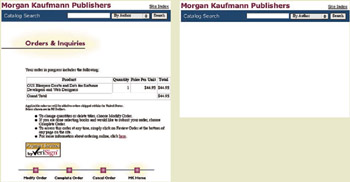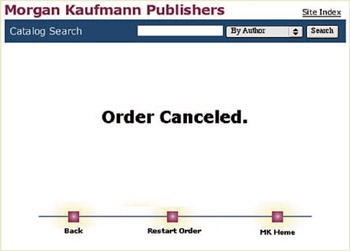Blooper 21: Missing Links: It s Back or Nothing
| < Day Day Up > |
Blooper 21: Missing Links: It's Back or Nothing
Some Web pages lack not only an indication of the current page, but any navigation links at all. This is a serious blooper that is unfortunately fairly common. It forces Web users to use the Back button or other browser controls to navigate away from the page. That may not sound too bad, but consider that
-
If the page was displayed in a new browser window, the Back button won't work.
-
Sometimes pages are displayed in browser windows lacking a Back button and other controls. [3]
Error Messages with No Way Out
Pages that display error messages are a common place to find this blooper. Apparently, when Web developers write code to display error messages, they often think of the message as if it were appearing in a dialog box, as in a desktop software application. When error messages appear in small pop-up dialog boxes, navigation controls aren't necessary because users need only close the window to resume what they were doing. But when error messages are just another Web page the browser displays, a lack of navigation links is a problem.
As an example, the website of the Feldenkrais Guild displays an error page with no navigation controls when a Search fails to find anything (Figure 3.42). A lack of navigation links is of course only one of many problems with this page (see Chapter 6, Blooper 42: Speaking Geek).

Figure 3.42: www.FeldenkraisGuild.com (Jan. 2002)-No navigation links provided when search finds nothing.
Sibelius.com displays a pretty unhelpful error message if a visitor's attempt to download software fails: "sql error."
However, for the present discussion, the text of the message is less important than the lack of any other information or links on the page (Figure 3.43).
"Task Completed" Pages with No Way Out
Web pages displayed when a task is completed or canceled are a second type of page that often lacks navigation controls. RussellStover.com used to display a Thank You message when a visitor successfully registered for email notification of site updates (Figure 3.44). The message appeared in the middle of an otherwise blank page, leaving users wondering what to do next . Fortunately, the company eliminated this problem when it upgraded its website.

Figure 3.43: www.Sibelius.com (Jan. 2002)-Error message displayed when software download fails. No navigation links on page; just a cryptic message.
Figure 3.44: www.RussellStover.com (Feb. 2001)-Thank You message displayed after a user signed up for email updates. No navigation links on page.
An example of the same blooper for a canceled ”rather than completed ”task occurs in the website of Morgan-Kaufmann Publishers. If you start to order a book, but click "Cancel Order" before getting to the end of the ordering sequence, you find yourself staring at a nearly blank page, with only a Search button and a barely noticeable Site Index link (Figure 3.45). It doesn't even acknowledge that the order has been canceled. The navigation controls at the bottom of most MKP.com pages are absent on this page.
Of course, most MKP.com users don't know the page is blank. When it appears, most will assume that the page simply hasn't finished downloading into the browser. They will waste many seconds waiting for it to download and then eventually notice that it has downloaded and is simply blank. Thus besides providing no obvious way out, this blank page delays users significantly even though it appears quickly.

Figure 3.45: www.MKP.com (Apr. 2002)-Blank page displayed after an order is canceled. What now?
404-Page Not Found
Every Web user has experienced the infamous "404 ”page not found" error. It often appears on an otherwise blank page, with no navigation controls or site identification. This is one of the most common causes of the "no navigation links" blooper.
Avoiding the Blooper
To avoid the blooper, all of the aforementioned example pages should include the standard navigation bar that appears on the site's "normal" pages. An example of how MKP.com's nearly blank cancellation page could avoid the blooper is shown in Figure 3.46.

Figure 3.46: Correction of blooper at www.MKP.com -Cancellation acknowledgment page is no longer mostly blank and includes variant of MKP's navigation bar at bottom.
At the very least, "task-completion" messages and confirmations should include a simple "Return to XYZ" button or link that displays whatever page is the appropriate restart point. Another way to put it is that there is no reason message pages should be considered any different from other pages, unless they will be displayed in pop-up windows.
To prevent the "404 ”page not found" variation of this blooper, sites can define pages to be displayed when that error occurs. Such pages should provide links back into the site or better the site's standard navigation bar and text-only links.
Don't leave visitors hanging. Always give them a way out.
[3] Browsers can be displayed in "kiosk" mode, meaning that display of browser controls is suppressed. Also, some software applications incorporate specialized Web browsers, which may or may not have the normal browser.
| < Day Day Up > |
EAN: 2147483647
Pages: 128